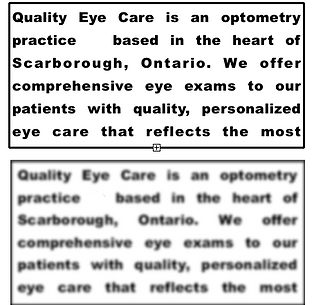
QUALITY EYE CARE
Mostafa Optometry Professional Corporation
Dr. Abdel-Karim Mostafa
Optometrist

TOP QUESTIONS WE HEAR FROM PATIENTS
OHIP COVERAGE FOR COMPREHENSIVE EYE EXAMINATIONS*
-
Children aged 0-19: Annual Comprehensive eye examinations and follow-up examinations.
Children may have a vision problem that can impact their ability to learn and participate fully in school and on the playground. The earlier a vision problem is detected the better the chances of successful treatment.
-
Adults aged 20-64 years: annual comprehensive eye examinations and follow-up examinations for people with :
-
Diabetes
-
Corneal Diseases
-
Retinal Diseases
-
Uveitis, acute or chronic during episode on inflammation.
-
Optic Pathway Disease
-
Patients receiving certain medication e.g. Plaquenil, Ethambutol, Methotraxate.
-
-
Seniors ages 65 and above: people aged 65 and older will be covered for one eye exam every 18 months, unless they have a condition affecting their eyes such as macular degeneration, glaucoma or diabetes..etc
-
Ontario Disability Support Program or Ontario Works **: persons receiving assistance through the Ontario Disability Support Program or Ontario Works will receive coverage for routine eye examinations once every two years.
More info: http://www.health.gov.on.ca/en/public/publications/ohip/eyecare.aspx
* In order to receive OHIP coverage, ALL patients are required to present a valid health card.
**Patients with ODSP or OW coverage must provide a drug card for the month of the examination along with the health card.
Do you accept private insurance?
Yes, we accept private insurance. If your insurance company and your insurance plan accept direct billing, we will submit your invoice online. Otherwise, you must pay the fees yourself and will receive an official receipt.

Does good vision mean I have healthy eyes?
It is important to know that having 20/20 vision doesn’t necessarily
mean you have healthy eyes..Eye checkups are not only for those
with poor vision. Regular eye examination is essential for detecting
eye issues before there are symptoms.


How often should I visit my optometrist?
If it's been more than a year since your last eye examination -- or if
you've never had one -- it's time to book a visit to the optometrist.

What can I do to look after my eyes?
Have a comprehensive eye examination regularly.
Dring this exam, your eye care professional examines your eyes thoroughly for any signs of damage or diseases. This is important to do regularly (at least yearly) in order to detect any issues before there are symptoms!




Recognize your risk factors
There are some components that can influence your eyes. Your age, having a systemic disease e.g. diabetes, your family history of eye diseases and your past history of trauma or diseases, etc. Your eye care professional can help you assess your risk factors and inform you about precautions.

Avoid smoking
Smoking increases risk of developing dry eye, age-related macular degeneration, cataract, and optic nerve damage.
Wear sunglasses and protective eyewear
Sunglasses protect your eyes from the sun’s harmful UV-rays which are associated with developing cataract and AMD. Goggles and safety glasses protect the eyes from trauma or the entry of any foreign bodies.


Eat right!
Eating a healthy diet can make a huge difference in the health of your eyes, much like the rest of your body. Try and incorporate these things into your meals:
-
Orange- colored fruits and vegetables e.g. carrots, they contain Beta-carotene, a type of vitamin A that helps the retina to function smoothly.
-
Fish and seafood, especially fatty fish (e.g. Tuna, salmon, mackerel, etc.), are rich in Omega 3, low levels of which have been linked to dry eye syndrome. All these foods are important for keeping your eyes healthy.
To lower the risk of developing macular degeneration and cataract:
-
leafy greens (e.g. spinach) and eggs, which are packed with lutein and zeaxanthin—antioxidants
-
citrus and berries, which are powerhouses of vitamin C almonds that filled with vitamin E.
What is the structure of my eyes?
The eye is our organ of sight. The eye ball is about one inch in diameter and located in a bony socket which is called the ORBIT. In the orbital socket the eye is cushioned by a pads of FAT. The movement of the eye is controlled by six muscles called the EXTRAOCULAR MUSCLES.


The eye has a number of components which include but are not limited to:
-
Conjunctiva: The conjunctiva is a thin, transparent layer of tissues covering the front of the eye.
-
Sclera: It is the white part of the eye that one sees when looking at oneself in the mirror is the front part of the sclera.
-
Cornea: It is the transparent, clear layer at the front and center of the eye. In fact, the cornea is so clear that one may not even realize it is there. The cornea is located just in front of the iris.
-
The anterior chamber: It is the fluid-filled space inside the eye between the iris and the cornea's innermost surface.
-
The anterior chamber angle: It is the actual anatomical angle created by the root of the iris and the peripheral corneal vault.
-
Iris: circular diaphragm forming the colored portion of the eye and containing a circular, central opening, the pupil.
-
Lens: is a clear, flexible structure that is located just behind the iris and the pupil. A ring of muscular tissue controls the convexity of the lens and, in turn, affects the accommodation of the eye.
-
Vitreous body: The vitreous humour is a transparent, colorless, gelatinous mass that fills the space in the eye between the lens and the retina.
-
Retina: a layer at the back of the eyeball containing cells that are sensitive to light and that trigger nerve impulses that pass via the optic nerve to the brain, where a visual image is formed.
-
Optic Nerve: The optic nerve connects the eye to the brain. transmitting impulses to the brain from the retina at the back of the eye

What is astigmatism?
Astigmatism is an imperfection in the curvature of your cornea (the front surface of your eye) or in the shape of the eye's lens. when the cornea is more oval or cylindrical than round, light does not focus properly on the back inside surface of your eye (retina). Astigmatism is caused by small differences in the growth and alignment of the components of the eye. In some cases, it may be hereditary or it may result from such factors as pressure of the eyelids on the cornea. Astigmatism may change with time. Regular optometric care can, however, help to insure that proper vision is maintained.
What is short/near sightedness (myopia)?
It is one of the refractive error (an eyesight problem) . Short sight leads to blurred distance vision, but close vision is usually normal.

What is long/far sightedness?
It is one of the refractive error (an eyesight problem). Long-sightedness leads to blurred close vision, but distance vision is usually normal.
